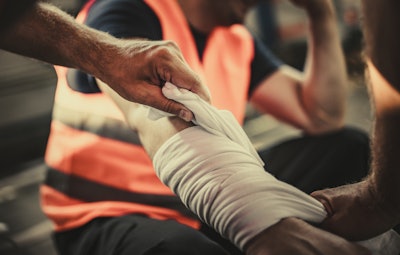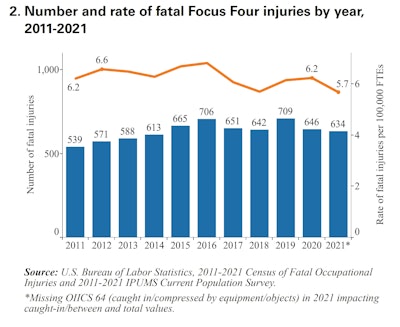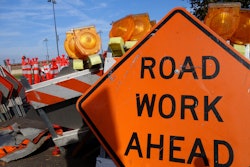
The U.S. Department of Labor Occupational Health and Safety Administration has proposed a revision to the federal regulations for personal protective equipment in the construction industry.
The revised rule would explicitly state that PPE must properly fit each employee, similar to requirements already in place in OSHA's general industry and maritime standards. Currently, the construction standard states that PPE “shall be provided, used, and maintained in a sanitary and reliable condition whenever it is necessary by reasons of hazards.”
The purpose of the proposed revision is to address a technicality that makes it difficult to enforce. The additional wording will allow OSHA to enforce the PPE standard more clearly if it observes an ill-fitted PPE in conjunction with an unprotected hazard.
“If personal protective equipment does not fit properly, an employee may be unprotected or dangerously exposed to hazards and face tragic consequences," said Assistant Secretary for Occupational Safety and Health Doug Parker.
Viewing the proposal as a clarification of the existing rule, OSHA officials say it would not likely impose any additional cost on employers and would not likely lead to a flood of new citations.
In most cases, it appears construction is already complying with the proposed rule; however, there are instances where more needs to be done, particularly for women and workers who do not meet standard sizes, worker advocates say.
“I think the vast majority of contractors are already thinking about this and realizing that one size does not fit all when it comes to gloves and things like that,” said Chris Trahan Cain, executive director of CPWR — The Center for Construction Research and Training, a nonprofit created by North America’s Building Trades Unions.
A recent, not yet published survey on PPE use by CPWR, found that 83% of respondents are already providing properly fitted PPE to their employees. This includes gloves, gowns, shoe covers, helmets and hard hats, masks, respirators, eye protection, face shields and goggles.
“It's kind of counterintuitive that they even have to do it,” she said. “If you'd have to provide PPE because you have a hazard on your jobsite and OSHA says that employers shall provide a job site free of hazards, one would logically think that if you're relying on PPE instead of eliminating the hazards, that the PPE will fit to eliminate the hazard.”
Cain considers the proposed revision a simple fix.
“It's just kind of fixing the regulations so that not only does the employer have to provide PPE, which they always have had to, but they must make sure it fits the worker," she said, noting that even without the revision if the PPE doesn't fit correctly, it might not work to protect the worker against a hazard.
Through research and collection of personal anecdotes, construction workers have reported situations to CPWR such as gloves not fitting and exposing skin to hazardous chemicals or getting caught in equipment or machinery.
Cain noted that improperly fitted clothing such as the high visibility vests often seen on road construction crews can be hazardous as well. If such a vest is loose or fits oddly, the vest can get caught up on tools or machinery that the worker is around.
In addition, she said, fall protection harnesses are typically built for men of a typical size range.
"There are people over that size range, and there are women who have different anatomical features that don't work with many of the existing fall protection harnesses," Cain said. “
Construction includes many high-risk occupations, with various safety and health hazards. In addition, it is composed of a diverse workforce, who may or may not fall into a certain “standard” size or body type in terms of getting PPE to have a proper fit.
For example, improperly fitting PPE can be an issue for small-stature construction workers, including some women, who may not be able to use PPE that is only available in a standard size.
CPWR’s analysis of U.S. Bureau of Labor Statistics data from 2011-2021 indicates that there are approximately 9.4 million construction workers, including 1 million or 9.8% who are women.
“The issue of PPE is just part of the safety and health hazards that we think women may experience more than men, because of the size differences,” Cain said. “There's lots of women who will fit into a size medium men's gloves with no problem at all, but there's always going to be outliers and probably more outliers on the small side in the women population.”
Potentially, the proposed rule could help reduce the barrier for women or others who find it difficult to obtain properly fitted PPE.
“Any barrier being removed for retaining women in the industry can only be good for the industry,” Cain said. From her perspective, implementation of such a rule change is particularly timely as the construction industry continues to work at being more inclusive.
"I think it's a good time for the industry to be thinking about this and making sure that they are welcoming all the workers that they need to perform the work," Cain said.
Per the proposed rule, anyone not providing properly fitted PPE will be required to do so. That could lead to some additional costs in buying new PPE and associated training in fit and use.
"It's important because when somebody's not able to use the PPE properly, they're at risk of getting injured or, God forbid, killed," said Joe Brandel, business development manager at Mips, which develops safety helmets.
Due to the various hazards, he noted that construction workers are among the highest risk for traumatic brain injuries. According to 2021 statistics from OSHA, one in five workplace fatalities happen in construction. Of those, more than one-third are related to slips, trips, and falls.
Brandel pointed out that a helmet or hard hat is not going to offer any protection from a head injury if it is not fitted correctly on the user's head.
“From the standpoint of the user, I think it's going to be much better because people are going to be more protected if they're able to wear their PPE with a proper fit,” he said. “That alone, I think, will cut down on injuries that were happening due to the improperly fitted PPE.”
Some PPE manufacturers may have to develop a better fitting products should the rule be approved.
“They're going to have to change up where and how it fits, offer a wider variety or probably offer more sizes,” Brandel said. "If you look at the sporting goods industry, if you buy a bike helmet or ski helmet, or a football helmet, it's not a one size fits all, there's different sizes. I think you're going to see that in the head-protection industry as well."
For a list compiled by CPWR of manufacturers who sell PPE designed for women: click here.
“I think that the segment of the manufacturing side has grown, and I'm sure they can meet the demand if it increases, which I hope it will,” Cain said.
OSHA has various rules and regulations rules that pertain to different industries. Within the same spectrum as construction, a nearly identical regulation relating to the proper fit of PPE already exists for general industry and maritime.
“It’s not like this is something really unusual,” Cain said, noting that OSHA tried to update the existing rule more than a decade ago through a more streamlined process.
Discussion of a rule to clarify the concept of requiring properly fitted PPE was originally discussed at a meeting of the Advisory Committee on Construction Safety and Health (ACCSH) in 2011.
Through the Standard Improvement Project Phase IV (SIP-OV) rulemaking process, a proposal of multiple revisions was brought forth, including the concept of adding the PPE fit requirement in 2016.
 Proper PPE use is believed to be a key factor in the number of injuries on a jobsite.CPWR
Proper PPE use is believed to be a key factor in the number of injuries on a jobsite.CPWR
Criticism from the Construction Industry Safety Coalition about the subjective nature of PPE being “properly fit” and how significant the rule change would be for the industry, prompted OSHA to remove the change at that time.
Despite the apparent positive nature of the proposal, the anticipation is that there will once again be pushback from within the industry.
OSHA is again accepting comments on the proposal and will be responsible for developing and maintaining a complete record to determine what the best course of action is.
Questions OSHA is asking of commenters:
- Will the proposal achieve more effective PPE protection than industry consensus standards?
- Is there confusion about what “properly fits” means for PPE used in the construction industry? If yes, what type of additional guidance should OSHA provide?
- How would the proposed revision impact the construction industry?
- What burden will the proposed change impose on employers in the construction industry?
Submit comments and hearing requests online using the Federal eRulemaking Portal and reference Docket No. OSHA-2019-0003. Read the Federal Register notice for details. Comments and hearing requests must be submitted by Sept. 18, 2023.













